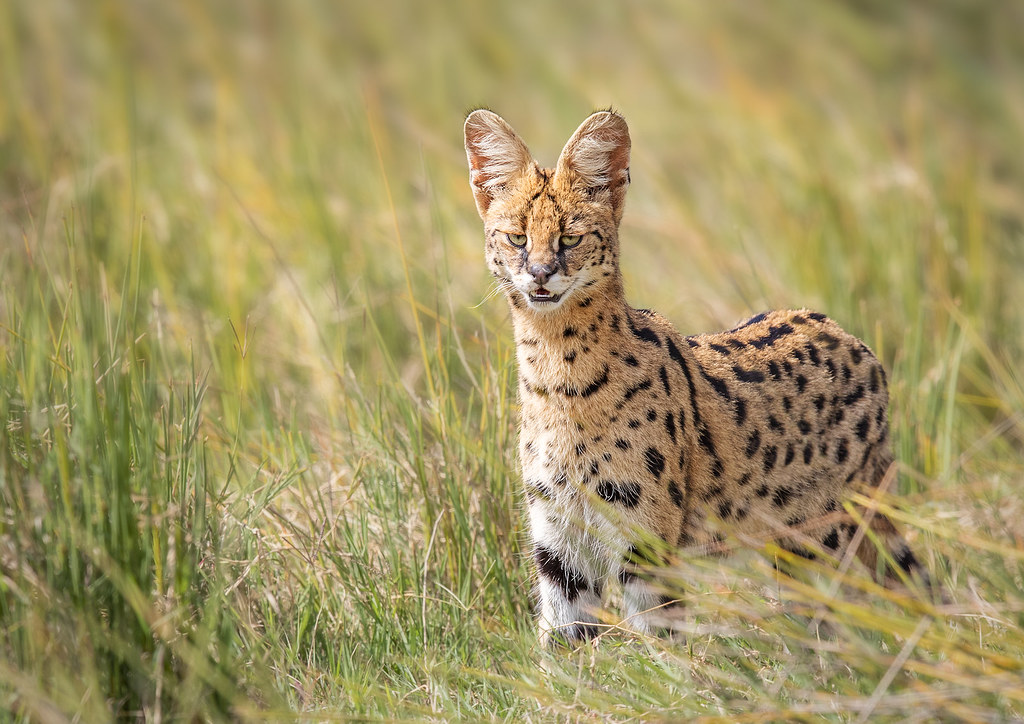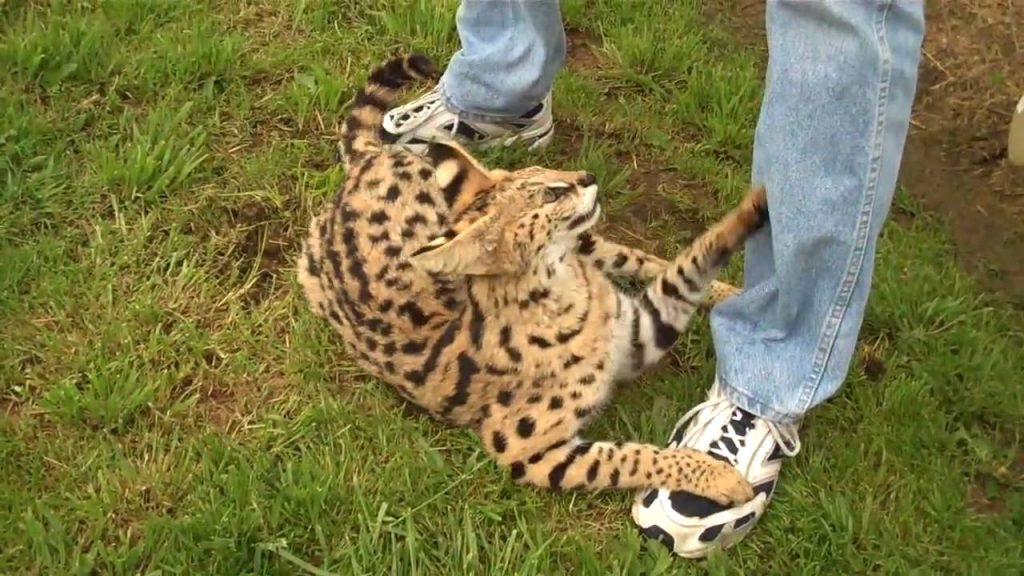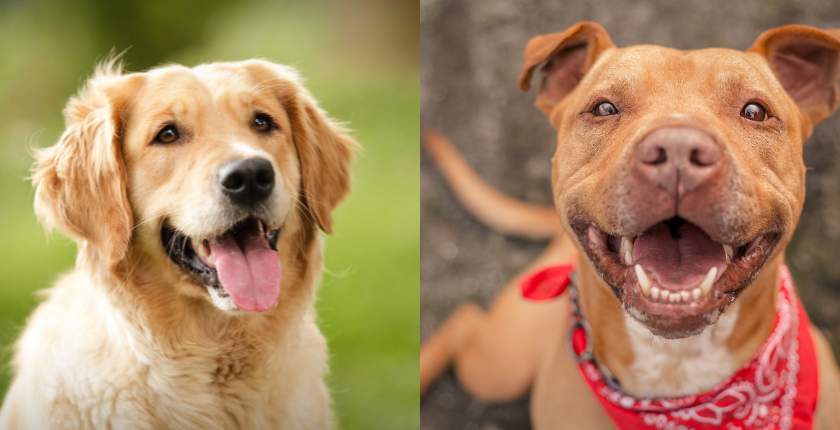Table of Contents
Can a Serval Cat Kill a Human: The serval cat is an exotic and wild animal that has captured the fascination of humans for centuries. With their long legs, keen hunting abilities, and athletic agility, servals possess remarkable skills adapted for survival in the African wilderness.
However, when it comes to servals as pets or captive animals, an important question arises – Can a Serval Cat Kill a Human, pitbull, or other dog? It’s crucial to understand both the capabilities and risks associated with these wild cats.
An Introduction to the Serval Cat

Before analyzing the potential dangers, let’s first understand what exactly is a serval cat.
What is a Serval Cat?
The serval is a medium-sized wild cat that is native to sub-Saharan Africa. With its long legs, large ears, and lean build, the serval is uniquely adapted for hunting in the grasslands and wetlands of its natural habitat.
Despite its exotic appearance, the serval is closely related to domestic cats. However, they have remained undomesticated. Servals can grow up to 24 inches tall at the shoulder and weigh around 20 to 40 pounds.
Physical Features and Hunting Abilities
Servals have many physical features that make them effective hunters, including:
- Long legs – Their elongated legs allow them to see over tall grasses when hunting and make high vertical leaps to catch prey. They can jump up to 10 feet in the air!
- Large ears – Their oversized ears help pinpoint prey location based on sound.
- Spotted coat – Their golden-yellow fur with black spots provides camouflage when hunting.
- Sharp claws – Servals have long, pointed claws that can be retracted while running and propel them forward when partially extended.
- Keen eyesight – They have excellent vision adapted for hunting small prey both day and night.
With these attributes, servals can hunt rodents, hares, birds, reptiles, and fish quite effectively. They use a cat-and-mouse technique, playfully catching prey but not killing it immediately.
Understanding Serval Behaviors Towards Humans

Servals are inherently wild animals that humans have attempted to tame or keep as pets over the years. But how do servals naturally behave around humans?
Wild Servals Tend to Avoid Humans
In the wild, servals generally fear and avoid contact with human beings. Since they inhabit remote wetlands and grasslands, encounters are rare. Wild servals that associate humans with danger will flee when they hear or see someone approaching.
Constant human traffic and encroachment into their habitats, however, can make wild servals lose their natural wariness over generations. But attacks on humans in the wild are extremely rare.
Captive Servals Can Get Habituated to Humans
When raised in captivity, servals become used to constant human presence and handling from a young age. Regular positive contact makes them more docile and less anxious around humans.
But their wild instincts remain, and captive servals can still be unpredictable. Aggressive behaviors like biting, scratching, or pouncing may be exhibited, especially by intact males. Poor early socialization or lack of mental stimulation contributes to difficulties in captive serval behavior.
Caution is Needed When Interacting with Servals
While servals very rarely attack humans unprovoked, it’s important to be cautious when interacting with them. Making sudden movements, threatening gestures, or approaching them directly can be seen as aggression and met with a defensive response.
Even supposedly ‘tamed’ servals require respect for their space and boundaries. Any wild animal is inherently dangerous, so servals should be handled only by experienced professionals.
Assessing the Risks – Can a Serval Cat Kill a Human at Home?
The risk of a serval fatally attacking a human is extremely low. But they can inflict serious injuries under certain conditions.
Cases of Serval Attacks are Rare
There are very few recorded incidents of serval cats injuring humans. Considering that they have been kept as pets and in zoos for decades, fatal attacks are virtually unheard of. Most bites or scratches occur due to mistakes in handling.
Potential for Danger Does Exist
Though rare in occurrence, the potential for danger cannot be ignored. With their sharp teeth and claws, servals can produce significant injuries if provoked or feeling threatened. Attacks generally happen when humans startle or attempt to handle an agitated serval.
If cornered and unable to escape, even tame servals may attack out of self-defense. Their powerful jaws and neck-biting hunting technique make bites to the face or neck particularly dangerous.
Lack of Prudence and Mishandling Raises Risk
While the risk is low, inappropriate handling and lack of caution greatly increase the chance of injury. Trying to pet, feed, or play with a serval without appropriate training or protective gear is ill-advised.
Letting young children near servals unsupervised is also extremely risky, given their prey drive and tendency to play rough even when just intending to be playful.
Capabilities to Kill a Human Under Specific Circumstances
While it would be highly uncommon, servals do possess the physical capabilities to fatally injure an adult human if sufficiently provoked or aggressive. With powerful jaws that can generate over 700 pounds of bite force, a serval can crush a human windpipe and rupture major arteries if biting the neck.
However, human deaths caused directly by servals are practically non-existent. Fatalities generally only occur when humans disregard common sense and safety precautions around these wild animals.
Can a Serval Cat Kill a Pitbull and Dogs?

Beyond humans, another major concern is whether servals present similar risks to other household pets, especially dogs.
Servals Can Kill Small and Medium Dogs
It is possible for servals to fatally injure smaller dog breeds. With their stealth hunting skills and neck-biting killing technique, servals can quickly dispatch small dogs weighing under 25 pounds.
Even medium-sized dogs like French bulldogs, Boston terriers, and corgis are vulnerable and have been attacked and killed by servals. Owners must be vigilant when servals and small pets share a home.
Pitbulls and Large Dogs Can Hold Their Own
Against fully grown pit bulls and larger dog breeds, a serval faces more of a challenge. Pitbulls have extremely powerful jaws that can exert over 235 pounds of bite force. They have been bred specifically for their strength and fighting ability.
While a fight between a serval and a pitbull could result in severe injuries for both, a healthy pitbull has the means to defend itself and possibly overpower an aggressive serval. The outcome depends on the individual animals, but pit bulls do have the potential to kill serval.
Risk is Always Present with Any Dog
That being said, risk is always present when servals interact with dogs. Servals are instinctive hunters who can perceive dogs as potential prey. Provocation or possessing a high prey drive can incite a serval to attack even large dogs or pit bulls.
Cats and dogs should ideally never be left alone unsupervised, as both can fatally injure the other under the right circumstances. Caution and slow supervised introductions are required for them to coexist.
Responsible Serval Ownership – Key Takeaways
While serious injuries are infrequent, owning a serval cat comes with an element of unpredictability and inherent risk that must be managed responsibly.
Consider Adopting Alternatives First
Many domestic cat breeds like the Savannah can fulfill the desire for an exotic cat without the challenges of owning a true wild serval. Adopting from a shelter also gives a home to a cat in need.
Ensure Proper Permitting and Housing
Acquire all necessary exotic animal permits, and provide appropriate secure housing with vertical space and enrichment. Never allow outdoors off-leash.
Proper Introduction to Other Pets
Carefully introduce servals to any resident pets and supervise all interactions. Rehoming may be needed if aggressive behavior arises.
Handle with Maximum Caution
Never directly interact with a serval without experienced supervision. Read warning signs like ears back and dilated pupils. Avoid sudden movements and don’t corner them.
Prioritize the Safety of Children
Do not leave serval cats and small children alone unsupervised. Childplay can incite predatory or play behaviors that lead to injuries.
With smart precautions and responsible care, the risk of a serval harming humans or pets can be minimized by respecting their wild nature.
People Usually Ask
Can a Serval Cat Kill a Human?
It is highly unlikely for a serval to intentionally kill a human being. There are no recorded incidents of fatal serval attacks on humans. While they can inflict serious bites and scratches, human fatalities caused directly by servals are practically nonexistent.
What if a serval feels threatened?
If a serval feels threatened or cornered, it may attack out of self-defense, like any wild animal. A serval’s sharp teeth and claws can produce significant injuries, especially around the face and neck. Screaming, swatting, or biting are warning signs a serval feels provoked.
Are serval cats safe with kids?
Servals and small children should never be left alone unsupervised. A serval may perceive a running or noisy child as prey and give chase. Their playful scratches and bites can also seriously injure a child, even if unintentional. Strict adult supervision is a must with kids.
Can a serval kill a dog?
Servals can and will kill small dogs that they perceive as prey, using their neck-biting technique. Medium dogs are also at risk. While pit bulls and large dogs can often defend themselves, injuries on both sides are possible if they fight. Dogs should never be left alone with a serval.
Can a serval be kept safely as a pet?
With proper precautions, servals can be kept as pets, but require experienced handlers and secure housing. However, they remain unpredictable wild animals that can be provoked to attack. Extreme caution is recommended, especially around children, strangers, and other pets.
Final Words
The exotic serval undoubtedly makes a captivating creature to admire, but one that also demands respect. While fatal attacks on humans are virtually unheard of, servals do have the potential to inflict serious harm if mishandled or feeling threatened. With prudent precautions, both servals and humans can maintain an appreciative coexistence with these remarkable African cats. Responsible education, ownership, and conservation are key to ensuring their continued place in the world.




